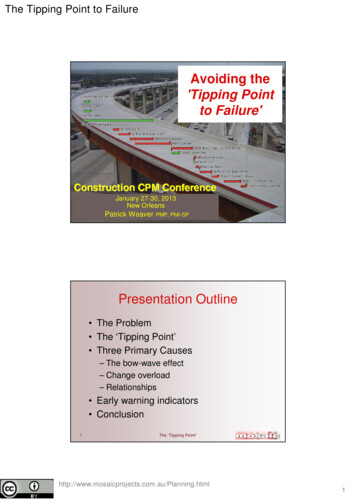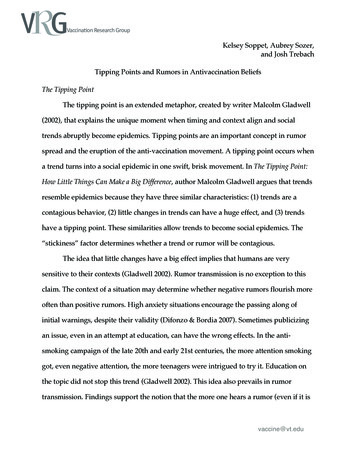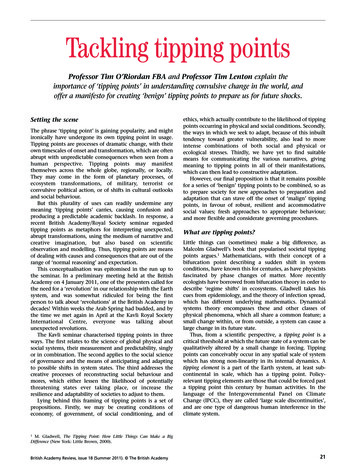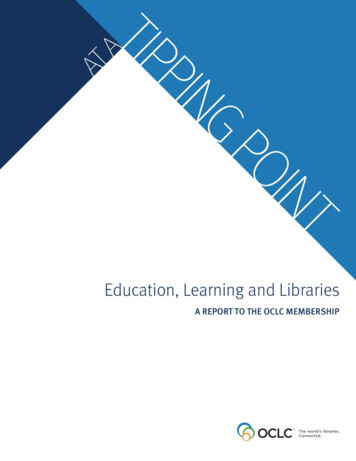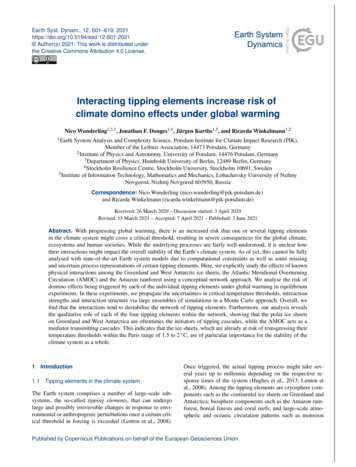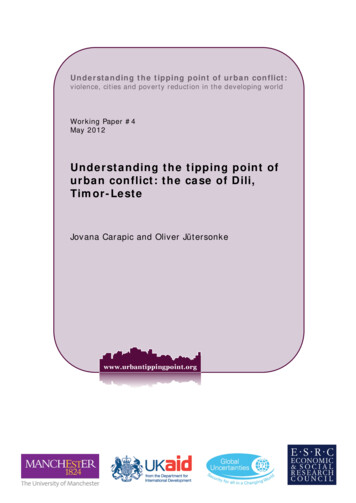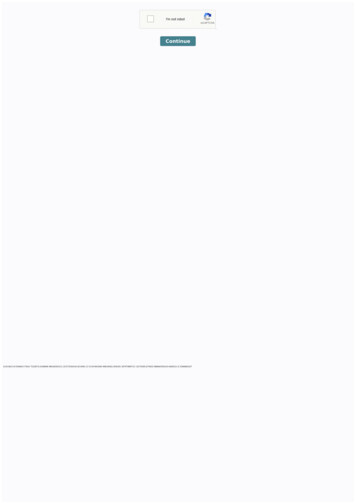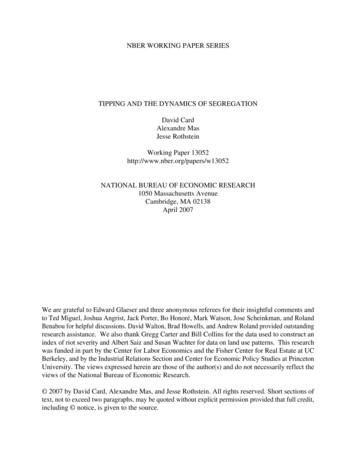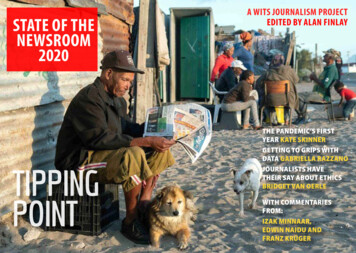
Transcription
State of theNewsroom2020tippingpointA Wits Journalism projectedited by alan finlayThe pandemic’s firstyear Kate SkinnerGetting to grips withdata Gabriella RazzanoJournalists havetheir say about ethicsBridget van OerleWith commentariesfrom:Izak Minnaar,Edwin Naidu andFranz Krüger
State of the Newsroom2020A Wits Journalism projectEditor and lead researcher: Alan FinlayFor Wits Journalism: Franz Krüger and Dinesh BalliahProduction, design and illustrations: Irwin ManoimProofreading: Lizeka MdaAdditional research: Kemiso Yasmine WessieWe would also like to thank the Press Council and theSouth African National Editors’ Forum for their contributions.This publication was made possible by the support of theSwedish International Development Agency (Sida) through theCHARM (Consortium to Promote Human Rights, Civic Freedomsand Media Development in Sub-Saharan Africa) f-the-newsroom/
STATE OF THE NEWSROOM 202034 Preface – Dinesh BalliahNew era for Wits Journalismcontents6 Introduction – Alan FinlayTipping the scales9 Newsroom in reviewCovid shreds print, boosts online news16181922IndicatorsMedia freedoms in 2020Print newsFree-to-air TV newsInternet newsFeatures23 How covid-19 shocked the media industry – Kate Skinner37 Decolonising data – Gabriella Razzano54 Are we serious about ethics? – Bridget van OerleInside angle62 Rebuilding a house we can trust – Edwin Naidu65 Tackling convergence at the Press Council – Izak Minnaar67 How to teach journalism to a disrupted profession – Franz KrügerAppendices70 Sanef media statements on media freedoms in 202073 Press Council complaints in numbers74 At the helm: Demographics of editors and board membersDay 59, lockdown, Cape Town.It’s not hard to find Abraham Waterloo.You simply go to the corner of St PeterAvenue, Seawinds, and chances areyou’ll see him there. He’ll be sitting onan upturned crate, his back to the wall,and he’ll be reading a newspaper. He’sreading his way through the lockdown.English, Afrikaans, on-day or old, itdoesn’t matter.Photograph: Jeffrey Abrahams,GroundUp (CC BY-ND 4.0)
STATE OF THE NEWSROOM 20204New era for Wits JournalismprefaceA new name, a reimagined future, a space for innovation. By Dinesh BalliahIt is a year of great excitement for WitsJournalism as we reconfigure ourselvesas the Wits Centre for Journalism – anew name which signals our reimaginedfuture as a space for innovative thinkingand leadership in the media sector, and injournalism education across the continent.The Centre will officially launch under theleadership of a new director in the comingmonths. The transition is fortuitously timedwith the Wits University centenary anniversary which itself marks a period of reflection and rejuvenation in higher education.As we say in the media, watch this space!This year’s State of the Newsroom –which looks back on 2020, and is appearing a little late due to delays in production– does not put an end to the narrative ofthe financial instability of the industry, butreveals signs of promise in how journalismis adapting to new ways of connecting withaudiences, telling stories and finding newspaces to thrive in. After two years of acovid-19 slump, there are still reasons foroptimism and hints of resurgence in thepost-pandemic world that lies ahead of us.The challenges in journalism, though, aremany – and some of them, such as the declining numbers of both newspaper readersand free-to-air TV news audiences on somechannels, police harassment of journalists,as well as the ongoing problem of mediaethics, are highlighted in this edition ofState of the Newsroom.At the end of last year, two journalistswere honoured with the Nobel Peace Prize.The honour, bestowed on Maria Ressa andDmitry Muratov, spotlighted the crucial rolethat journalism plays in democracy despitethe hurdles in its way. “We are standingon the rubble of the world that was, andwe must have the foresight and courageto imagine what might happen if we don’tact now, and instead, create the world asit should be – more compassionate, moreequal, more sustainable,” said Ressa in heracceptance speech.The need for good journalism is not in decline as many assert – it is in unprecedenteddemand – but how to fund it remains theburning question. The trust deficit in therelationship between journalists and audiences remains a significant threat to theviability of media businesses, and to the relevance of the media in society. Without thistrust, the relationship does not exist.Ressa also reminds us of the various
STATE OF THE NEWSROOM 2020forms of violence that journalists continueto face, violence often facilitated by onlineplatforms or Big Tech companies. In SouthAfrica, this violence – against women journalists in particular – is concerning to WitsJournalism as we train and prepare youngpeople for life in the field.We have made the necessary but regretful move to include mandatory safetytraining in our curricula along with mentalhealth counselling as we recognise the immediate and long-term impact of workingunder the relentless spectre of violence andthe resulting trauma on journalists.Over the course of this pandemic, wehave not only lost jobs, revenue and titles,we have also lost a number of colleagues inthe industry to this devastating virus. Theyare too many to name here, but Wits Journalism recognises and salutes each one fortheir contribution to South Africa’s manystories.A word of thanks must go to everyonewho made this State of the Newsroom possible, particularly Alan Finlay, the lead researcher and editor. Many others played arole, and are acknowledged elsewhere.We are particularly grateful for the support from the Swedish International Development Agency, through the Consortium toPromote Human Rights, Civic Freedoms andMedia Development in Sub-Saharan Africa,which Wits Journalism is part of.Dr Dinesh Balliah is acting director, WitsJournalismThe two journalists honoured withthe Nobel Peace Prize, Maria Ressaand Dmitry Muratov: the awardspotlighted the crucial role ofjournalism in a democracy, despitethe hurdles.5
introductionSTATE OF THE NEWSROOM 20206Tipping the scalesA year of shock, confusion and a need to radically adapt. By Alan FinlayThis issue of State of the Newsroom deals with three key topics: it offers a summary of theimpact of the covid-19 pandemic on the media in South Africa in2020 – a year of shock, confusion and adapting to a new reality; it explores the difficultterrain of data and data governance, andhow this country’s media should be re-orientating themselves to a local data narrative; and it asks a group of media practitioners what they thought of Sanef’s reporton media ethics.All these – the pandemic and its long-termaftershocks, the fast-emerging data economy, and the chronic challenge of earningback a sense of media credibility and publictrust – have the potential to tip the scalesfor better or for worse when it comes to thefuture robustness and value of journalism inSouth Africa.It is common conversation by now how thelockdown shredded the print media – withmany pointing to the impact on the magazine trade and on community newspapers.Several well-known magazine titles wereshut down by magazine giants Media24 andCaxton & CTP Publishers & Printers in 2020,while a number of local newspapers eithershut down or were shuffled around to beamalgamated under one title.By the end of the year, at least 10 localpapers had been terminated in one way oranother – a blow to community news andaccountability in towns and smaller cities,arguably where they are needed the most.The first year of the pandemic unsurprisingly also damaged mainstream newspa-per circulation, accelerating the downwardtrend in copies sold seen over the past several years. By the end of the year, it was clearthat weekly and weekend papers had beenhit the worst, on average losing nearly halftheir circulation (compared to a steep butsteady 8-13% decline in previous years). Dailies didn’t escape the maelstrom, on averagemore than trebling their circulation lossesfrom previous years.It was not all bad news, as Kate Skinner inher wrap on the first year of the pandemic argues. For instance, she points to the“counter trends of innovations and improvements in the quality of news and reporting,especially on health topics”, the bold leapinto print by the Daily Maverick, and News24seizing the spike in internet audiences as themoment to put some of its content behind a
paywall. (However, this raises the questionof what content should remain free-to-access in the public interest, especially duringtimes of national crises).While it seems clear that the mediadid a good job in taking on the challengeof bringing the news to the public duringthe difficult early stages of the pandemic– alongside public education content – theyear was also deceptive. TV showed recordaudiences in the first month of lockdown– with SABC 3 News, struggling in recentyears, attracting a whopping 65% moreviewers. But audience levels, perhaps because of news fatigue, quickly returned totheir downward trend for some free-to-airstations.By the end of the year, the top primetime news slots on eTV and SABC 3 attracted around half of their 2016 audience numbers. This apparent end-of-year disinterestin TV news was also seen in the dwindlinginterest in President Cyril Ramaphosa’s addresses to the nation on covid-19.While no doubt 2020 was as tough forlaw enforcement officers as it was for journalists, what is worrying is the increase inA worryingincrease inincidents wherejournalistswere assaulted,harassed, beatenup or shot at bymembers of thepolice forcethe number of reported incidents wherejournalists were assaulted, harassed,beaten up or shot at by members ofthe police force. In 2019, only two incidents were reported, and we considered aggression from the policetowards journalists – alongsidesurveillance threats and otherforms of harassment fromthe state – as issues thatA dwindling interest in President Cyril Ramaphosa’saddresses to the nation on covid-19, echoed an apparentdisinterest in television news generally by the end of 2020.STATE OF THE NEWSROOM 2020needed attention. In 2020, 12 separate incidents were reported, only some of whichcan be attributed to the messiness of enforcing lockdown regulations. Some weremore serious than others, withjournalists needing medical attention, but it seems that it isquite common for the police to casually insist thatjournalists delete theirfootage.Sometimes thethreats and harassment from the policeare localised. In 2020a number of incidentswere reported7in Cape Town as well as in Paarl, wherethere appears to be systemic harassmenthappening. Why this is happening needsto be better understood – is it a lack oftraining, ignorance, or a wilfulflouting of the law? Or is itan indication that ideasof democracy and theimportance of a freemedia are not sharedby the people whoare meant to protectthat democracy?In her article on decolonising data, Gabriella Razzano argues howimportant it is for media
STATE OF THE NEWSROOM 2020organisations to understand the emergingdata economy better. This means understanding the nature of data itself – whatit can and cannot do. Organisations needto come to grips with data governance, acritical issue as the African Union startsto build a collaborative policy frameworkto limit and incentivise the data economyso that the continent does not continue tobe overwhelmed by data-rich nations andcorporations. The practical implicationsfor this new frontier need to be properlymapped for newsrooms, but the suggestions of where to start are already there.Razzano calls for a uniquely African “datanarrative” to emerge. While newsroomswill never have the capacity to competewith the economies of scale benefitingthe likes of Facebook and Google, they dohave other market advantages that allowthem to interpret data differently: a betterunderstanding of the local environment,a more refined understanding of readers,micro economies, and of societal needs,including language needs.The balance between this localised, interpretative benefit, and the benefit ofeconomies of scale, is not a given; but itdoes mean that media organisations havea competitive edge that cannot be easilyOnly somejournalists hadread the Satchwellreport, while somedid not even knowthat it existedreplicated by platformisation or artificialintelligence – a potential to speak moremeaningfully to audiences. (If anything,the pandemic has shown the importanceof local data in building local narratives).Two of the commentary pieces in thisissue touch on this theme from differentangles. Izak Minnaar argues that the mediaregulatory environment has not kept upwith audience behaviour and technologicalchanges, and summarises how the PressCouncil has gone about to fill this lacuna,including beginning to develop a cross-plat-form code of ethics and conduct.Meanwhile, Franz Krüger in his commentary on teaching journalism in Africa pointsto the need to understand the “specificways in which journalism and informationworks and is changing on the continent”.What is evident is that there are uniqueopportunities in Africa to create new, andmore meaningful types of journalism driven by the changing needs of the continent’scommunications environment.Concerns over journalist ethics peakedin 2019 with the allegations at the ZondoCommission of several instances of journalists being paid to write stories.As the media tries to rebuild the public’s trust – and we can see this in the waysome editors and publishers are responding swiftly and directly to lapses in editorial practice – this is not the case across theentire industry (see Edwin Naidu’s acerbiccommentary on the state of trust in theSouth African media in this issue of State ofthe Newsroom).In her survey of 16 media practitionersgauging their response to Sanef’s inquiryinto media ethics (the so-called SatchwellReport), which was released in early January 2021, Bridget van Oerle found that onlysome had read the report, while some did8not even know that it existed. This needsto be balanced with journalists who clearlyhad thought deeply about the report’s issues and implications, as well as with whatseemed to be a reasonable sense of theethical obligations of the media amongstall respondents surveyed. Nevertheless,that a key instrument for change such asthe Satchwell Report goes unnoticed bythe very practitioners it talks about is acause for concern.
STATE OF THE NEWSROOM 2020Newsroom in reviewA terrible year for print media, withmagazine and community titles guttedby the flight of advertising revenueunder the covid-19 lockdown.While journalists braved the threatof the virus amongst their own ranks,and a spike in harassment by police,online news and broadcast drew recordreaders and audiences.In a welcome relief, the Secrecy Bill wassent for review and Sanef released itsreport on media ethics toherald the start of the second year ofthe pandemic.By Alan Finlay9Covid-19 eviscerates printThe nationwide lockdown due to the covid-19 pandemicthat began at midnight on March 26 eviscerated analready fragile print media industry, with the magazinetrade and community newspapers suffering the mostserious blows. (See the article by Kate Skinner in thisissue of State of the Newsroom for more on the impactof the pandemic on the media industry).Advertising revenue plummeted across most media– reports put this anywhere between a 40% andcomplete absence of ad placements for the period.Caxton & CTP Publishers & Printers, publisher of TheCitizen and a number of community newspapers,reported a 60% drop in revenue.1Journalists across the board were forced to takepay cuts – some as high as 45% – while freelancerssaid they lost as much as 80% of their income.2 Mediahouses pushed through with retrenchment plans,despite the pandemic. An estimated 700 jobs werelost to the industry at the start of the lockdown.The circulation of mainstream newspapersdropped steeply, with daily, weekly and weekendpapers all suffering circulation declines of 37 – 47%.3Both Associated Media Publishing4 and Caxton &CTP said they would shut their magazine divisionssoon after the lockdown was gazetted, whileThe iconic magazine Cosmopolitan, oncehugely profitable, was one of several titles tobe closed during the covid-10 lockdown.
STATE OF THE NEWSROOM 2020Media24 announced in July that it wouldclose a number of its magazines, outsourcesome, and move others online.Closures affected well-known titles suchas Cosmopolitan, House and Leisure andMen’s Health. Media24 also shut downfour community titles, with some mergedinto single papers.5 By the end of the year,at least 10 local newspapers had stoppedpublishing across the country.The biggest jobs cuts were announced byCaxton & CTP, which said it would lay off25% of some 6 000 staff. Meanwhile theSABC, as part of its ongoing turnaroundstrategy, said in June that it would likelyretrench about 600 of its almost 3 000employees, including journalists.6 In JulyMedia24 announced plans to retrench 510staff members, saying that its print mediaoperations would not recover from theimpact of the pandemic.710Responding to the crisis, in July Saneflaunched a relief fund for journalists.8Substantial corporate donations werereceived from, amongst others, MTN,which provided seed funding, FirstRandand Standard Bank, with the Open SocietyFoundation for South Africa followingsuit. The fund raised over R4.8 million.Successful applicants received R5 000 each.By the end of the year it had approved 249applications, and disbursed over R1.2million.9The Association of IndependentPublishers (AIP) meanwhile criticised theMedia Development and Diversity Agency(MDDA), which set up its own emergencyrelief fund for journalists, but gaveapplicants only three days to apply. Therealso appeared to be a lack of transparencyin disbursements.10Other high-profile magazinetitles to close included House andLeisure and Men’s Health.
Bucking the trend However it was not bad news foreveryone in the industry. The onlinenews site Daily Maverick took thebold move of launching a newspaperedition in August – Daily Maverick 168.11The newspaper was circulated via Pick nPay outlets across the country.Meanwhile, with internet traffic soaringunder lockdown – traffic to some newssites was reported to have increased bysome 72% – News24.com launched itsdigital subscription service in the samemonth. TV audiences also spiked, withthe SABC recording a 40% increase in thenumber of people tuning into its isiZulu TVnews and a 60% increase for its isiXhosa TVnews slot soon after the national state ofdisaster was declared.12Harassment ofjournalistsThe media were deemed essentialservices under the government’sDisasterManagementActregulations, which also saw the deploymentof some 76 000 SANDF troops acrossTraffic to somenews websitesincreased byover 70%, whileTV audiencesspiked, with SABCrecording a 40%increase for isiZuluTV newsthe country to help manage the crises.13However many of them were ill-preparedand untrained for the job of ensuring thelockdown regulations were followed.By the end of March – only a few daysinto lockdown – an escalation of attackson journalists and harassment by both thepolice and the defence force was reported.Early incidents included a News24journalist being shot at in Johannesburg,and a Weekend Argus photographer havingher cellphone confiscated in Cape Town.14Despite calls by Sanef and the South African Freelancers’ Association (Safrea) forSTATE OF THE NEWSROOM 2020the right of journalists to properly coverthe pandemic to be respected, the harassment of journalists by security forcescontinued through the following months.Amongst other incidents,15 in April journalists were prevented by police from entering the courts in Cape Town to report onthe case of a 55-year-old Parow man whowas arrested under new disinformationregulations for posting a video about contaminated covid-19 test kits.Also in April journalists were preventedfrom documenting the removal of refugeesand asylum seekers in the Cape Town CBD,and were denied access to a homeless shelter set up at a sports centre. In May, Sanefreported that community media journalistPaul Nthoba had been forced to flee thecountry and seek refuge in Lesotho. Nthoba was assaulted by the police while covering their enforcement of lockdown regulations.1611Mishandling theinformation crisisComplaints emerged during thelockdown that President CyrilRamaphosa was not making himselfavailable for journalist briefings on thepandemic.While regular briefings with the newlyformed National Coronavirus CommandCouncil (NCCC) took place, there were noquestion-and-answer sessions with thepresident during the unfolding crisis, inparticular after his intermittent addressesto the nation which were broadcastnationally.17This despite there being several areas ofconfusion on the regulations passed duringphases of the lockdown, as well as someconcern over the de facto powers of theNCCC and its relationship to cabinet andparliament.18The complaints over Ramaphosa’sunavailability followed his assurances tosenior journalists from across the mediasector in March – and ahead of lockdown– that he would reinvigorate the necessarylevel of contact between cabinet and themedia, and that it was important for themedia to interact with the government on
STATE OF THE NEWSROOM 2020all levels, including on issues to do with histime in office and leadership.19In March the Committee to Protect Journalists and others expressed concern overnewly passed regulations that criminaliseddisinformation about the pandemic fortheir potential to stifle criticism of any government mishandling of the crisis.20 Meanwhile tensions between the media and theNCCC flared in May when questions wereraised as to whether the command council was ignoring advice from the MinisterialAdvisory Committee on covid-19 (MAC) – agroup of biomedical and public health experts that had been formed to advise theNCCC.This was after Professor Glenda Gray, aprominent MAC member and president ofthe South African Medical Research Council, openly criticised government regulations for being irrational and unscientific.21These tensions were compounded bythe government’s poor communicationson the scientific basis of its decisions forwhat often appeared to be ad hoc regulations on a range of issues. It was only in lateAugust, following pressure from the mediaand civil society, that the department ofhealth made its MAC advisories public.22While the media in general rose to thetough challenge of keeping a watchful eyeOn the frontlineThe first journalist’s death fromthe virus was reported onMay 13 – Cape Town-basedeNCA cameraman Lungile Tomhad died three days earlier.23 Thetragedy sent shockwaves throughthe industry and demonstratedhow vulnerable journalists were incovering the pandemic, both in andoutside of the newsroom. Severalmore journalists were to die aftercontracting the virus in the monthsto come, despite health protocolsbeing instituted in most newsroomsacross the country.In August the prestigious Nat Nakasa Award was awarded to all South Africa’sjournalists in a show of solidarity with the risks journalists had to face in reportingon the pandemic.24on any abuse of power under the country’snewly declared state of disaster, while alsomaking critical health information availableto the public, this sometimes came at aprice. Despite its financial woes, the publicbroadcaster was required to flight publicservice content, which included extended news coverage of the pandemic, andpublic health and educational informationon the virus in all of the country’s officiallanguages. SABC stations – which have thebiggest reach in South Africa’s broadcast12terrain – were also required to provide airtime for government briefings. Howeverthis that meant the cash-strapped broadcaster, having recently threatened mass retrenchments and restructuring, lost crucialadvertising revenue during the pandemic.No public funding was offered to the SABCto deliver on its public service mandate.More controversy ateNCA.The eNCA newsroom continued to bedogged by controversy in 2020 (Seethe previous issue of State of theNewsroom), this time after news anchorsXoli Mngambi and Jane Dutton were taken off air for criticising the government’slockdown cigarette ban on live broadcast inMay. This was despite what was understoodas a requirement by eNCA management forits anchors to be “more opinionated and toopen their shows on social and political issues”. The sanctioning of the two anchorsfollowing viewer complaints was criticisedby Sanef amongst others. Sanef raised concerns about the “potential undermining offreedom of expression at eNCA”.25
STATE OF THE NEWSROOM 2020Review of SecrecyBill welcomedIn June news that President Ramaphosawas to review the Protection of State Information Bill – the so-called Secrecy Bill– in order to align it better with the Constitution was welcomed by media stakeholders. A key sticking point for the mediain the draft law was the lack of a public interest defence to the sharing of protectedinformation – an absence that would severely cripple journalists’ ability to investigate and report.26 According to Sanef, thereview would allow for the provision to beintroduced. The bill, which was to replacethe apartheid-era Public Information Actof 1982, had been passed by parliament,but remained unsigned for several yearsfollowing numerous public objections. Besides the absence of the public interest defence, the bill allowed for a 15- to 25-yearjail term for any journalist found to have‘’classified” documents in their possession.EFF ordered to apologise and payfor Stratcom allegationsIn January former co-editor of the Weekly Mail Anton Harber and then journalistat the newspaper, Thandeka Gqubule, won their defamation case against theEconomic Freedom Fighters (EFF).27 This followed unfounded allegations made onTwitter by the EFF that they had worked for Stratcom – the name of the apartheidstate’s covert disinformation campaign – while at the Weekly Mail (see State of theNewsroom 2018 for details of how the allegations emerged). The court ordered theEFF and its national spokesperson, Mbuyiseni Ndlozi, to apologise for calling themspies and to pay the two R40 000 each in damages.allegations againstthe Daily MaverickIn March allegations were made by aUnisa student that the Daily Maverick hadpaid a number of Wits students to writenegative stories about Public InvestmentCorporation (PIC) CEO Dan Matjila,Independent Media owner Iqbal Survé andthe EFF. The student had previously writtenfor the online news site.The allegations – which the DailyMaverick denied – had been published onIndependent Online. There was, however,a lack of evidence to substantiate theclaims, and a subsequent intervention bySanef determined that the allegations werelikely false.Zondo adjournedIt was a tough year for journalism ethicsat the Judicial Commission of Enquiryinto State Capture (Zondo Commission)in 2019 (see last year’s State of theNewsroom). In comparison, 2020 wasquiet, with the commission adjourned13for most of the year due to the covid-19lockdown.Journalist Ranjeni Munusamy announcedthat she did not intend to cross-examinecrime intelligence officer DhanajayaNaidoo and senior Hawks investigatorKobus Roelofse, despite being given leaveby Judge Zondo to do so at the end of 2019.This was after the two alleged thatjournalists, including Munusamy, had beenon the payroll of crime intelligence, anallegation Munusamy denied in a detailedaffidavit. Munusamy cited the legal costsof preparing for cross-examination as thereason for her not wishing to proceed.28InNovember,Munusamywascontroversially appointed as a communityoutreach officer in the National Treasury,despite the allegations. However herappointment was defended in parliamentby Minister of Finance Tito Mboweni whosaid he was satisfied with the explanationgiven by the former Sunday Timesassociate editor, and that he had no reasonto believe that she would not be cleared bythe commission.29
STATE OF THE NEWSROOM 2020Sanef ethics reportreleasedIn January 2021, the long-awaited reportfrom a commission of inquiry into mediaethics – the so-called Satchwell Report –was released.30 The 300-page report wascompiled by a panel made up of retired judgeKathleen Satchwell and veteran journalistsRich Mkhondo and Nikiwe Bikitsha. It hadbeen commissioned by Sanef in 2019,following a series of damaging reports inthe Sunday Times between 2011 and 2016that were subsequently retracted (seeState of the Newsroom 2018), and in thewake of damning allegations of journalismcorruption made at the Zondo Commission.The report was the result of the inputof some 167 individuals and organisations– including editors and journalists, mediaowners, academics and members of thepublic – and a review of nearly 200 documents. It included 69 detailed recommendations on issues such as media freedom,media diversity, ethics and standards, financial resources, the safety and securityof journalists, continuing professional development, and regulatory bodies, withspecific recommendations also focusing onthe Sunday Times.The ethics reportwas the result ofthe input of some167 individualsand organisatioinsincluding editorsand journalists,media owners andacademicsWhile the report endorsed the criticalrole played by self-regulatory bodies suchas the Press Council and the BroadcastingComplaints Commission of South Africa(BCCSA), it pointed to the negative impactof several cross-cutting issues on journalism ethics.These included resource-strapped newsrooms, a lack of editorial checks-and-balances, a lack of training and skills development in the newsroom, and fierce pressurefrom social media forcing newsrooms tobreak stories faster.Misinformation and disinformation wasalso hampering the media’s work as werethe effects of pressures such as the harassment of journalists, an
Tipping the scales Newsroom in review Covid shreds print, boosts online news Indicators Media freedoms in 2020 Print news Free-to-air TV news Internet news Features How covid-19 shocked the media industry - Kate Skinner Decolonising data - Gabriella Razzano Are we serious about ethics? - Bridget van Oerle Inside angle
